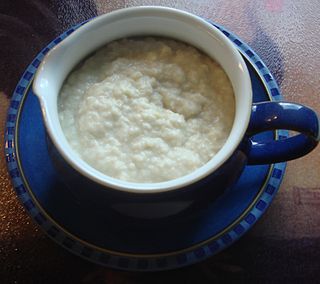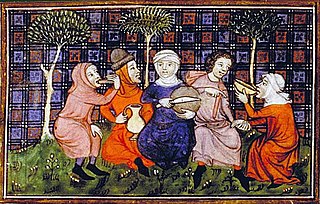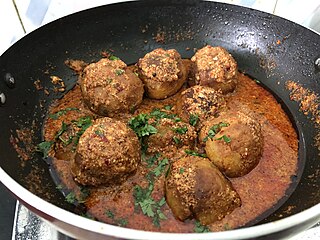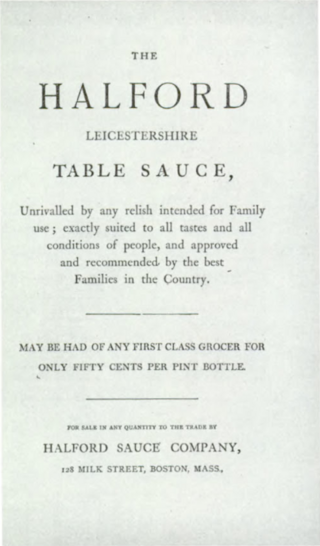Related Research Articles

A kitchen is a room or part of a room used for cooking and food preparation in a dwelling or in a commercial establishment. A modern middle-class residential kitchen is typically equipped with a stove, a sink with hot and cold running water, a refrigerator, and worktops and kitchen cabinets arranged according to a modular design. Many households have a microwave oven, a dishwasher, and other electric appliances. The main functions of a kitchen are to store, prepare and cook food. The room or area may also be used for dining, entertaining and laundry. The design and construction of kitchens is a huge market all over the world.

The cuisine of ancient Rome changed greatly over the duration of the civilization's existence. Dietary habits were affected by the political changes from kingdom to republic to empire, and Roman trading with foreigners along with the empire's enormous expansion exposed Romans to many new foods, provincial culinary habits and cooking methods.

A cookbook or cookery book is a kitchen reference containing recipes.

Macaroni and cheese is a dish of cooked macaroni pasta and a cheese sauce, most commonly cheddar sauce.

A bread sauce is a British and Irish warm or cold sauce made with milk, which is thickened with bread crumbs, typically eaten with roast chicken or turkey.

A larder is a cool area for storing food prior to use. Originally, it was where raw meat was larded—covered in fat—to be preserved. By the 18th century, the term had expanded: at that point, a dry larder was where bread, pastry, milk, butter, or cooked meats were stored. Larders were commonplace in houses before the widespread use of the refrigerator.
A royal household or imperial household is the residence and administrative headquarters in ancient and post-classical monarchies, and papal household for popes, and formed the basis for the general government of the country as well as providing for the needs of the sovereign and their relations. It was the core of the royal court, though this included many courtiers who were not directly employed by the monarch as part of the household.

Mint sauce is a green sauce originating in the United Kingdom, made from finely chopped spearmint leaves soaked in vinegar, and a small amount of sugar. Lime juice is sometimes added. The sauce based on mint and vinegar has a rather thin consistency and is flecked with chopped leaves of the herb. In British and Irish cuisine it is often served as a condiment for roast lamb or, in some areas, mushy peas.
The still room is a distillery room found in most great houses, castles or large establishments throughout Europe dating back at least to medieval times.

Medieval cuisine includes foods, eating habits, and cooking methods of various European cultures during the Middle Ages, which lasted from the fifth to the fifteenth century. During this period, diets and cooking changed less than they did in the early modern period that followed, when those changes helped lay the foundations for modern European cuisines.

Llajua or llajwa is a Bolivian chili sauce prepared from locotos hot chili peppers, and tomatoes; sometimes onions are added to the mix. One or two seasoning herbs could be added, depending on the region and taste: quillquiña in Cochabamba and wakataya in the Altiplano and other valleys of Bolivia. Llajua is also made and consumed in Northwest Argentina due to its close proximity to Bolivia. It is preferably prepared on a grinding stone called a batán, which can be found in most Bolivian households of Cochabamba and Altiplano. In the absence of a batan, it can be prepared in a blender.
A spicery was the office in a medieval or Renaissance household responsible for spices, as well as the room in which the spices were kept. It was headed by a spicerer. The office was subordinated to the kitchen or the wardrobe, and existed as a separate office only in larger households. It was closely connected with other offices of the kitchen, such as the saucery and the scullery. The term is largely obsolete today, and if used at all is more often simply a synonym for spices.
A chandlery was originally the office in a wealthy medieval household responsible for wax and candles, as well as the room in which the candles were kept. It could be headed by a chandler. The office was subordinated to the kitchen, and only existed as a separate office in larger households.
A scalding house was the office in a medieval household responsible for scalding the carcasses of animals, as well as utensils. It was also the room in which this activity took place. It was headed by a scalder. The office was subordinated to the kitchen, and existed as a separate office only in larger households. It was closely connected with other offices of the kitchen, such as the saucery and the scullery.
A poultry was the office in a medieval household responsible for the purchase and preparation of poultry, as well as the room in which the poultry was stored.

Dum aloo or aloor dum or aloo dum is a potato-based curry dish. Dum means slow-cooked, and aloo is potato. It is a part of the traditional Kashmiri Pandit cuisine, from the Kashmir Valley, in the Indian state of Jammu and Kashmir. Dum aloo is cooked widely in India and Pakistan. There are also Banarasi and Bengali variations.

Mignonette sauce is a condiment made with minced shallots, cracked pepper, and vinegar traditionally served with raw oysters.

Salsa verde is a type of spicy, green sauce in Mexican cuisine based on tomatillo and green chili peppers.

Babi kecap is an Indonesian braised pork with sweet soy sauce. It is a Chinese Indonesian classic, due to its simplicity and popularity among Chinese Indonesian households. It is also popular among non-Muslim Indonesians, such as the Balinese, Ambonese, Bataks, Minahasans, Dayaks, and in the Netherlands among the Indo-Dutch, where it is known as babi ketjap, owing to colonial ties with Indonesia. In the Netherlands, the dish might also be served within an opulent rijsttafel banquet.

Halford Leicestershire Table Sauce, also Halford sauce or Leicestershire sauce, was once as common a condiment in the United States as ketchup is today. The product was similar to Worcestershire sauce, with some recipes of the time using it interchangeably.
References
- ↑ Woolgar, C. M. (1999). The Great Household in Late Medieval England. New Haven and London: Yale University Press. pp. 111, 144. ISBN 0-300-07687-8.